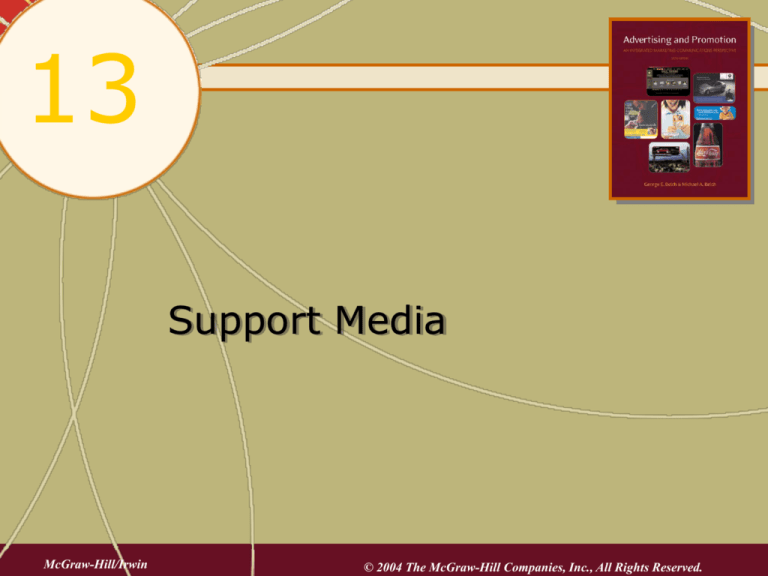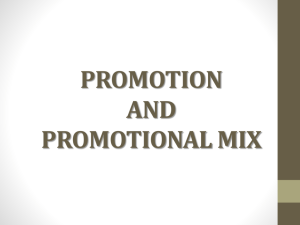
13
Support Media
McGraw-Hill/Irwin
© 2004 The McGraw-Hill Companies, Inc., All Rights Reserved.
Support Media
Various other media used to deliver
marketing communications and to
promote products and services. Includes:
Out-of-home media
Billboards, transit ads, in-store media
Promotional Products (Specialty advertising)
Yellow Pages Advertising
Advertising in Movie Theaters and Videos
Product Placements in Television and Movies
In-flight advertising
Other
Outdoor Advertising
Three Major Forms:
Posters – used for shorter time periods
30-sheet (standard and bleed) 12 ft. x 25 ft.
8- sheet (junior poster) 5 feet x 11 feet
Painted bulletins – largest and most prominent
measure 14 ft x 48 but can be larger
can be permanent or rotary
Spectaculars – large unique displays, usually
electronic and use movement, color, graphics
Outdoor Advertising Advantages
Wide Local Coverage
Broad base of day and night local exposure
Frequency
High exposure for frequently purchased goods
Geographic Flexibility
Can be placed on highways, near stores, etc.
Creativity
Use of color, size, shape, and movement
Creation of awareness
Use of short, high-impact messages
Efficiency
CPM very competitive with other media
Effectiveness
Can often lead directly to sale of the goods
Production Capability
Technology has reduced production times
Outdoor is Creative
Outdoor Advertising Disadvantages
Wasted coverage
The market isn’t geographically concentrated
Limited message capability
Limited reading speed and exposure time
Wearout
High frequency may lead to quick wearout
High cost
Due to reduced availability and cost creep
Measurement Problems
Frequency and reach are hard to ascertain
Image Problems
Adverse publicity, regulation degrade image
Buying Outdoor Advertising
Outdoor advertising purchased on basis of:
gross ratings points or showing
One ratings point = 1 percent of market’s population
Usually purchased in increments of 25, 50, 100
100 showing or GRPs means that message will
appear on as many panels as needed to provide
daily exposure equivalent to total size of the market
Other Out-of-Home Media
Aerial Advertising
Sky Banners
Sky Writing
Blimps
Mobile Billboards
Trucks
Vans
Trailers
In-Store Media
Signs/Banners/Displays
Video displays
Kiosks
General Motors uses mobile advertising
Other Outdoor Media
Parking meters
ATM displays
Trash cans
Ski lift poles
Car top signs
Sidewalk signs
Garden plantings
Wall drawings
Types of Transit Advertising
Inside Cards
Placed above seats
In luggage areas
Outside Posters
On the sides, backs, roofs
On busses, taxis, trains, etc.
Station, Platform, Terminal Posters
Floor displays
Island showcases
Electric signs, posters
Transit Advertising Advantages
Exposure
Captive audience with little else to do
Frequency
Especially high with daily commuters
Timeliness
Exposure coincides with shopping trips
Selectivity
Geographically selective for local ads
Economy
Low absolute and relative cost
Transit Advertising Disadvantages
Image Factors
Image in minds of public and advertisers is poor
Reach
Unable to reach those who don’t use transit
Waste Coverage
Many who aren’t potential customers are exposed
Copy and Creative Limitations
Format strictly limits copy and creative options
Mood of the Audience
Transit situation may engender bad feelings
Promotional Products Marketing
Promotional products marketing is the
advertising or promotional medium or
method that uses promotional products,
such as ad specialties, premiums,
business gifts, awards, prizes or
commemoratives.
Specialty Advertising Defined
A medium of advertising, sales promotion, and
motivational communications employing
imprinted, useful, or decorative products called
advertising specialties, a subset of promotional
products.
Unlike premiums, with which they are
sometimes confused, these articles are
always distributed free: Recipients don’t
have to earn the specialty by making a
purchase or contribution.
Ad specialty items come in many forms
Source: Courtesy California Milk Processor Board.
Promotional Products Advantages
Selectivity
Controlled distribution to target prospects only
Flexibility
Endless variety of forms provides versatility
Frequency
Long retention means constant exposure
Economy
Many inexpensive items available in large quantity
Goodwill
Only medium generating goodwill in receiver
Augmentation
Often used to supplement other promotional media
Promotional Products Disadvantages
Image
Some items may cheapen the image
of advertiser
Saturation
Some items are overused, some
audiences saturated
Lead Time
Time required to develop a
promotional product message is
longer than for most other media
Forms of Yellow Pages
Specialized Directories
Targeted to special audiences
(Hispanics, Women, Blacks, Christians)
Audiotex
“Talking” Yellow Pages
Interactive
Consumer search data bases
Internet Directories
National, regional and local listings
Other Services
Coupons, inserts, samples
Yellow Page Advertising
Advantages
Disadvantages
Wide Availability
Market Fragmentation
Action Oriented
Timeliness
Low Cost
Lack of Creativity
Frequency
Lead Times
Non-Intrusiveness
Clutter
Movie Theater Advertising
Advantages
– High Exposure
– Audience Mood
– Cost (Maybe)
– Good Recall
– Lack of Clutter
– Proximity
– Segmentation
Disadvantages
• Irritation
• Cost
• Consumer Backlash
Product Placements
Showing the product or service or
advertisement for it as part of a
movie or television program
Product Placements
in Movies and Television Programs
Disadvantages
Advantages
High exposure
High frequency
Media support
Source association
Economy
High recall
Bypass regulations
Viewer acceptance
High absolute cost
Time of exposure
Limited appeal
Lack of control
Public reactions
Competition
Negative placements
BMW is a Frequent User of Product
Placements
In-Flight TV Commercials
Advantages
• A Desirable Audience
• A Captive Audience
• Low Relative Cost
• Segmentation
Possibilities
Disadvantages
• High Potential for
Irritation
• Limited Availability of
Medium
• Lack of Audience
Attention
• Potential for Rapid
Wearout


